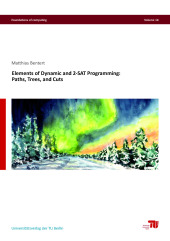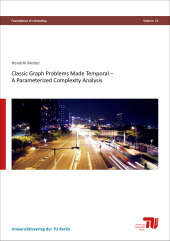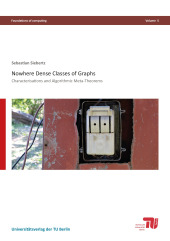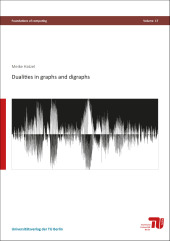Exploiting structure in computationally hard voting problems
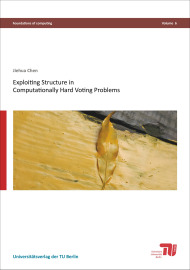
Format: 14,8 x 21,0 cm
Publishing year: 2016
This thesis explores and exploits structure inherent in voting problems. Some of these structures are found in the preferences of the voters, such as the domain restrictions which have been widely studied in social choice theory [ASS02, ASS10]. Others can be expressed as quantifiable measures (or parameters) of the input, which make them accessible to a parameterized complexity analysis [Cyg+15, DF13, FG06, Nie06]. Accordingly, the thesis deals with two major topics. The first topic revolves around preference structures, e.g. single-crossing or one-dimensional Euclidean structures. It is covered in Chapters 3 to 5. The second topic includes the parameterized complexity analysis of two computationally hard voting problems, making use of some of the structural properties studied in the first part of the thesis. It also investigates questions on the computational complexity, both classical and parameterized, of several voting problems for two widely used parliamentary voting rules. It is covered in Chapters 6 to 8. In Chapter 3, we study the single-crossing property which describes a natural order of the voters such that for each pair of alternatives, there are at most two consecutive voters along this order which differ in their relative ordering of the two alternatives. We find finitely many forbidden subprofiles whose absence from a profile is necessary and sufficient for the existence of single-crossingness. Using this result, we can detect single-crossingness without probing every possible order of the voters. We also present an algorithm for the detection of single-crossingness in O(nm2) time via PQ trees [BL76], where n denotes the number of voters and m the number of alternatives. In Chapter 4, we study the one-dimensional Euclidean property which describes an embedding of the alternatives and voters into the real numbers such that every voter prefers alternatives that are embedded closer to him to those which are embedded farther away. We show that, contrary to our results for the single-crossing property, finitely many forbidden subprofiles are not sufficient to characterize the one-dimensional Euclidean property. In Chapter 5, we study the computational question of achieving a certain property, as for instance single-crossingness, by deleting the fewest number of either alternatives or voters. We show that while achieving single-crossingness by deleting the fewest number of voters can be done in polynomial time, it is NP-hard to achieve this if we delete alternatives instead. Both problem variants are NP-hard for the remaining popular properties, such as single-crossingness or value-restriction. All these problems are trivially fixed-parameter tractable for the parameter “number of alternatives to delete” (resp. “number of voters to delete”) because for each studied property there are finitely many forbidden subprofiles whose removal makes a profile possess this property. In Chapter 6, we introduce a combinatorial variant of CONTROL BY ADDING VOTERS. In CONTROL BY ADDING VOTERS as introduced by Bartholdi III, Tovey, and Trick [BTT92], there is a set of unregistered voters (with known preference orders), and the goal is to add the fewest number of unregistered voters to a given profile such that a specific alternative wins. In our new model, we additionally assume that adding a voter means also adding a bundle (that is, a subset) of other voters for free. We focus on two prominent voting rules, the plurality rule and the Condorcet rule. Our problem turns out to be extremely hard; it is NP-hard for even two alternatives. We identify different parameters arising from the combinatorial model and obtain an almost complete picture of the parameterized complexity landscape. For the case where the bundles of voters have a certain structure, our problem remains hard for single-peaked preferences, while it is polynomial-time solvable for single-crossing preferences. In Chapter 7, we investigate how different natural parameters and price function families influence the computational complexity of SHIFT BRIBERY [EFS09], which asks whether it is possible to make a specific alternative win by shifting it higher in the preference orders of some voters. Each shift has a price, and the goal is not to exceed the budget. We obtain both fixed-parameter tractability and parameterized intractability results. We also study the optimization variant of SHIFT BRIBERY which seeks to minimize the budget spent, and present an approximation algorithm which approximates the budget within a factor of (1 + epsilon) and has a running time whose super-polynomial part depends only on the approximation parameter epsilon and the parameter “number of voters”. In Chapter 8, we turn our focus to two prominent parliamentary voting rules, the successive rule and the amendment rule. Both rules proceed according to a linear order of the alternatives, called the agenda. We investigate MANIPULATION (which asks to add the fewest number of voters with arbitrary preference orders to make a specific alternative win), AGENDA CONTROL (which asks to design an appropriate agenda for a specific alternative to win), and POSSIBLE/NECESSARY WINNER (which asks whether a specific alternative wins in a/every completion of the profile and the agenda). We show that while MANIPULATION and AGENDA CONTROL are polynomial-time solvable for both rules, our real-world experimental results indicate that most profiles cannot be manipulated by only few voters, and that a successful agenda control is typically impossible. POSSIBLE WINNER is NP-hard for both rules. While NECESSARY WINNER is coNP-hard for the amendment rule, it is polynomial-time solvable for the successive rule. All considered computationally hard voting problems are fixed-parameter tractable for the parameter “number of alternatives”.
